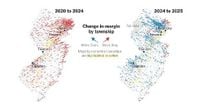The 2025 gubernatorial races in New Jersey and Virginia delivered political shockwaves, upending expectations and offering a revealing snapshot of the American electorate in the early days of President Donald Trump’s second administration. With both states hosting their first major elections since Republicans reclaimed the White House and Congress, the contests became a referendum on pocketbook issues, political identity, and the shifting allegiances of key voting blocs—especially in suburban and heavily Hispanic areas.
Nowhere was this more evident than in New Jersey, where Representative Mikie Sherrill clinched the governor’s mansion after a fiercely contested and record-breaking campaign. According to AP, the race was the most expensive in the state’s history, drawing national attention as a litmus test for the Trump administration’s policies and their local impact. Sherrill’s victory over Republican Jack Ciattarelli was hard fought, but her campaign’s focus on affordability and cross-party appeal ultimately paid dividends.
“She has a lot of crossover appeal with Republican voters,” Darcy Draeger, chairwoman of the Morris County Democrats, told the AP. Sherrill’s roots in the county—about 30 miles west of New York City, with a population that’s two-thirds white, slightly wealthier than the national average, and highly educated—helped her bridge divides in a region that has become increasingly competitive over the past decade.
The importance of cost-of-living issues was echoed to the south in Virginia, where Democrat Nicole Cole toppled a 36-year Republican incumbent in Spotsylvania County. Cole’s campaign, as reported by AP, was laser-focused on the everyday economic pain points facing voters: “We would greet them at the point of purchase,” Cole explained, describing how her team campaigned in grocery stores, highlighting items like $3.79 eggs, $7.99 ground beef, and $9.39 coffee beans. “That’s when it hurts most.”
The result? Thirteen Virginia Democrats flipped competitive House seats, contributing to sweeping wins for the party in both states. “Early on in my campaign, when I brought in my staff, one of the main messages I talked to them about was that we need to stop saying this district is red, and that it leans red,” Cole said. Her approach, which blended economic messaging with a focus on public education and utility bills, proved prescient. At a Fredericksburg town hall just two weeks before the election, she told voters, “You know you have to have heat and air, and a utility bill that has to get paid. So then something else is a sacrifice. The quality of food that you’re able to buy for your kids is a sacrifice.”
Back in New Jersey, the electoral map told a story of dramatic swings in suburban and exurban counties. Morris County, for instance, had narrowly flipped to Trump in 2024 by just under three percentage points, but in 2025, Sherrill edged out Ciattarelli, a reversal that underscored the volatility of the region. According to AP, Morris County is a bellwether: in 2020, it backed Democrat Joe Biden by four points, then swung to Republican Ciattarelli by more than 11 points in the 2021 governor’s race, before Trump narrowly carried it in 2024. This time, the pendulum swung back to the Democrats.
The reasons for these shifts are complex, but many voters seemed to be reacting to the Trump administration’s policies and their tangible effects on daily life. “People are watching the news and they’re looking to see what goes on in Trump’s administration, and they are seeing how it affects people locally, and with the whole government shutdown and people losing their SNAP benefits,” said Democrat Marisa Sweeney, whose district includes part of Morris County. “We’re talking about people within our own communities.”
Republicans, too, acknowledged the challenge of breaking through the national noise. “We need to make sure that our constituents understand that we are here to serve and that we’re listening to their voices,” said state Senator Anthony Bucco of Morris County. “I think the message was drowned out a little bit by Washington.”
Perhaps the most significant storyline of the 2025 New Jersey governor’s race, however, was the Democratic Party’s resurgence among Hispanic voters—a group that had stunned political observers by swinging toward Trump in 2024. As reported by The New York Times, a township-level analysis revealed that heavily Hispanic areas which had shifted sharply to the right in 2024 swung decisively back to the left in 2025. The results in these communities closely resembled Ciattarelli’s 2021 loss, rather than Trump’s striking 2024 performance.
The numbers tell the tale: in majority-Hispanic towns, Trump had garnered 39% of the vote in 2024, up from 27% in 2020, but Ciattarelli’s share in 2025 dropped to 24%, almost identical to his 2021 showing. This reversal suggests that Trump’s surge with Hispanic voters may have been “fleeting, or at least not transferable to other candidates in his party,” as The New York Times put it. Both Sherrill and Ciattarelli campaigned aggressively for Latino votes, but it was the Democrat who ultimately reclaimed ground lost just a year earlier.
Passaic County, a northern New Jersey area with a large Latino population, exemplified this trend. The county, which had voted for Trump in 2024—the first time it had gone Republican in decades—swung back to the Democrats by double digits in 2025. John Currie, the longtime Democratic chairman in Passaic, attributed the turnaround to “hard work” by Democratic candidates and a focus on affordability. “Affordability – it’s that simple,” Currie said pointedly.
For Sherrill, the path to victory was not just about recapturing lost voters, but also about offering a vision that resonated across party lines and demographic groups. According to a NJ Advance Media newsletter published November 15, 2025, Sherrill’s campaign was marked by behind-the-scenes discipline and a keen understanding of the state’s political landscape. Her future plans, the newsletter noted, include continuing to address the cost-of-living crisis and building coalitions that reflect New Jersey’s diverse electorate.
Meanwhile, in Virginia, voters like Kaitlyn Sapp—who admitted, “I did not vote this year. I have not been very political. But recently, I have been trying to learn more”—hint at a broader shift in civic engagement. As Cole and other Democrats rattled off plans to tackle health care costs, public education, and utility bills, the message was clear: the party sees opportunity in addressing voters’ everyday anxieties, especially in regions that have long leaned Republican.
The 2025 elections in New Jersey and Virginia, then, were about far more than partisan scorekeeping. They were a vivid reminder that political fortunes can turn on the price of groceries, the reliability of a utility bill, or the perceived responsiveness of elected officials. As Democrats Mikie Sherrill and Abigail Spanberger (in Virginia) prepare to take office, they do so buoyed by victories that were anything but inevitable—and by a mandate to deliver on the economic promises that carried them over the finish line.
With the dust settling, both parties are left to ponder the lessons of 2025: in a nation where political tides can shift overnight, listening to voters’ lived experiences may be the surest path to staying afloat.





